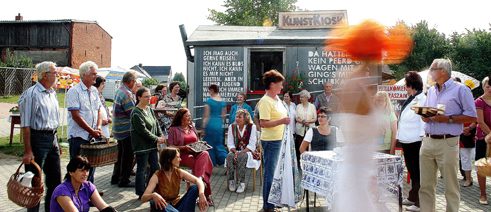Participatory Art
A Village Gets Going

The entire life of a village changes in one place. Asylum seekers are given a voice in another. Interesting participatory projects are emerging far away from metropolitan areas. Two cases.
Artist Barbara Caveng, who has been involved in participatory projects since 2003, moves to Blankensee-Pampow in 2013 to spend six months in this hamlet located in Western Pomerania right on the German-Polish border. Blankensee-Pampow had applied to take part in the project “Art for the Village – Villages for Art” and was one of the three villages to earn the award. In a few words: Barbara Caveng becomes the village’s artist-in-residence. At the end of March 2013 she moves to an apartment in this locality that the townsfolk had otherwise been fleeing. Instead of the former 700 residents, only 570 people live here now. The trend is downward – high time, then, for something to happen.
What belongs together grows together
Caveng, herself a Berliner by choice, spends weeks visiting local residents here and there, on both sides. The village, which merged in 2004, consists of two districts, Blankensee and Pampow, which are divided by a two-kilometer-long road lined with meadows and forests. She often hears people from the two sides saying: “We live here, they live there. We are not one community.” This very statement lays the groundwork for Barbara Caveng’s participatory work. She soon realizes that, rather than uniting the two communities, this road sets a barrier between them. This has to change.“There should be a place where people come together to meet and exchange ideas,” says Barbara Caveng. This place became an old construction site trailer dating back to GDR times, and now known as the “Kunstkiosk” – “ArtKiosk.” Barbara Caveng describes the ArtKiosk as a “We-venture”: She stirs the residents from both Pampow and Blankensee into action, forms different task forces and together they convert and redesign the trailer. The “ArtKiosk” sells products from the region and the villagers must make active use of this space, not only during the artist’s stay but also after she leaves. Whether tourists cycling through the village along the Oder-Neisse bike trail can be supplied with coffee and cake – or not – will thus depend on the villagers and on the extent they cooperate.
The villagers get to know each other
But the kiosk alone will not do the trick. Together with the residents, Barbara Caveng has created a new town square right on the middle of the road between the two localities. This spot is called Pampsee and features its own town sign – ‘Pampsee. Art community 2013. West Pomerania-Greifswald County.’ The kiosk is located here, as is a fourteen meter long wood sculpture that draws its inspiration on the woodpiles typical of the area. With logs pushed back on the stack to make the letters visible, a resident’s statement appears on the sculpture and makes clear to passers-by how things now stand in the village: ‘MI KRICHT HIER KEENER MEHR WECH,’ which translates roughly as ‘Nobody gonna get me outta here now.’ The project obviously has paid off for Barbara Caveng: the village has grown close, the road teems with life again. The people from Pampow speak to the people from Blankensee, and viceversa.I’ll give you a voice
Silvia Wienefoet was artist-in-residence at the Schoeppinger Kuenstlerdorf, between Muenster and the Netherlands. During her stay, she also realized a participatory project. She often noticed groups of people walking past the artists’ village on their way to the supermarket. They spoke Arabic, Turkish, Russian. “In this place there is a central shelter for asylum seekers,” the artist explains. During the course of her stay, she realized that this had to become the subject of her art. “Those people only spend a short time in this place without knowing where they will go next. Unfortunately, the everyday life of these asylum seekers does not overlap at all with that of Schöppinger residents.” Just like in Barbara Caveng’s case, Silvia Wienefoet integrates the peculiarities of a place into her art and relates the local people into her work in order to bring about change.You really do exist
The artist visited the asylum seekers in their temporary housing. Hours of long and intense conversations followed with these men and women from all over the world who had fled the war or the economic plight in their home countries. The collection of statements and quotes that Silvia Wienefoet gathered from them lies at the heart of her project. An abandoned transformer tower located between the artists’ village and the supermarket became a ‘tower of quotes’. In Wienefoet’s view, Schoeppinger residents and asylum seekers walking by would converge in this way – a common ground, a kind of understanding has emerged, she thinks. “People who participated were proud of having their words on display. The fact that their names and ages appear in writing for everyone to see gave them the feeling of reassurance that they, in fact, exist as individuals in this place.”Barbara Caveng’s show “Heimisch” will take place at the Galerie im Saalbau in Berlin from February 1 to April 6, 2014. The exhibition is about the project in Blankensee-Pampow.